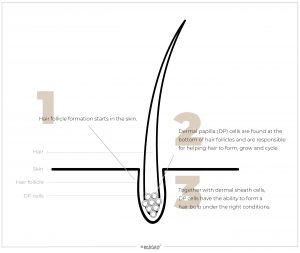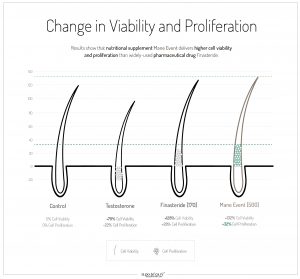– PRESS RELEASE –
In a recent independent in vitro lab study, results show that nutritional supplement Mane Event® delivers higher cell viability and proliferation than widely-used pharmaceutical drug Finasteride.
Mane Event® is a vegan, TGA-listed Australian-made supplement combining targeted vitamins, minerals, amino acids and herbs to deliver the nutrients required by the body to promote hair health and growth and relieve hair loss.
Finasteride is a drug which is used to increase hair growth on the scalp and prevent further hair loss by decreasing testosterone production and reducing the ability of androgens to bind to DP cells in the scalp.
Finasteride has traditionally been the leading pharmaceutical drug prescribed for androgenetic alopecia (male-pattern baldness).
Understanding hair
A hair follicle can be defined as the cavity or sheath of cells and connective tissue which surround the root of a hair.
Hair follicle formation starts in the skin.
Dermal papilla cells (DP cells) are found at the bottom of hair follicles and are responsible for helping hair to form, grow and cycle.
Together with dermal sheath cells, under the right conditions, DP cells have the ability to form a hair bulb.
[CLICK TO ENLARGE]
Hair Growth Cycle
Hair follicles go through three phases in their life cycle:
PROLIFERATION or GROWTH
RESTING
INVOLUTION or SHRINKAGE
[CLICK TO ENLARGE]
The role of hormones
Within the human body, sex hormones (androgens) influence the growth or proliferation of hair.
In people who are predisposed to baldness, DP cells are particularly susceptible to hormonal changes, in particular changes in testosterone levels.
While testosterone is thought of as the male sex hormone, women also have testosterone albeit in smaller amounts.
For people who are genetically susceptible to hair loss and baldness, testosterone decreases DP cell function and decreases the growth phase of hair follicles,[i] causing shrinkage and death of hair follicles.
A key way to help hair thinning and baldness is to improve the activity and proliferation of DP cells to improve hair follicle growth.
Pharmaceutical drug Finasteride works by decreasing testosterone production and has been shown to slow hair loss and reduce the ability of androgens to bind to DP cells in the scalp.[ii]
Mane Event® is an Australian made vitamin, mineral, amino acid and herbal supplement which provides the human body with nutrients which are structural components of hair to help strengthen and promote healthy hair growth and assist with hair loss.
The Study
A recent in vitro study involving Mane Event® alongside drug Finasteride found Mane Event® increased the number of human follicle papilla cells in comparison to the number increased by Finasteride.
Both Mane Event® and Finasteride showed improvements in viability and creation (proliferation) at all concentrations.
The optimum concentration of Mane Event® (500 µg/mL) showed the best results with changes in cell viability of 132% and 32% cell proliferation.
At the optimum concentration of Finasteride (170 µg/mL) the change in viability was 128%, with cell proliferation of 28%.
– Explained –
The study compared Mane Event® to Finasteride and how each affects dermal papilla cells in vitro.
A widely acceptable and reliable way to test how a product affects hair growth is to measure the ability of the cells to grow and transform into the hair shaft and inner root sheath, is the MTT Cell Proliferation Assay.
The MTT test measures:
1. the viability and proliferation of cells involved in hair growth when exposed to different agents, in this case, Mane Event®, Finasteride or testosterone; and
2. how quickly cells multiply, if they die off and how quickly this happens.
The test uses compounds called tetrazolium salts, these salts are used by cells to produce compounds called NADH and NADPH. The more NADH and NADPH that is created, the more viable and active the cells are.
In this study, cells were exposed to Mane Event®, Finasteride and testosterone solutions at different concentrations and the production of NADH and NADPH was measured. The diagram below shows results after 48 hours. When numbers are above 100, it shows a positive effect on cell viability and below 100 a negative effect (cells die off).
Both Mane Event® and Finasteride showed improvements in viability and creation (proliferation) at all concentrations.
The optimum concentration of Mane Event® (500 µg/mL) showed the best results with changes in cell viability of 132% and 32% cell proliferation.
At the optimum concentration of Finasteride (170 µg/mL) the change in viability was 128%, with cell proliferation of 28%.
Testosterone results showed the cells were active, however there was no increase in viability and it had a negative impact on DP cells, with a 22% reduction in cell numbers at the highest tested concentrations.
The control showed no change (as expected).
[CLICK TO ENLARGE]
– Conclusion –
Mane Event® showed an improvement in the viability of the cells which form the hair shaft and inner root sheath. The best results were seen at treatment of 500 µg/mL (+132% viability), which was greater than the highest concentration of Finasteride (+128%).
These results indicate that Mane Event® is able to improve hair follicle health which in turn results in healthier hair.
Mane Event® was also able to increase the proliferation of the DP cells. Again, the best results were seen at treatment of 500 µg/mL (+32% proliferation), which was greater than the highest concentration of Finasteride (+28% proliferation).
These results indicate that Mane Event® is able to improve hair follicle proliferation which may in turn result in accelerated hair growth.
Apotecari® is committed to continuing scientific research into their product range to deliver effective products to customers and create products based on scientific research.
References
[i] Rastegar H, Ashtiani HA, Aghaei M, Barikbin B, Ehsani A. Herbal Extracts Induce Dermal Papilla Cell Proliferation of Human Hair Follicles. Annals of Dermatology. 2015;27(6):667-675. doi:10.5021/ad.2015.27.6.667.
[ii] Habif TP (23 April 2015). Clinical Dermatology. Elsevier Health Sciences. pp. 934




